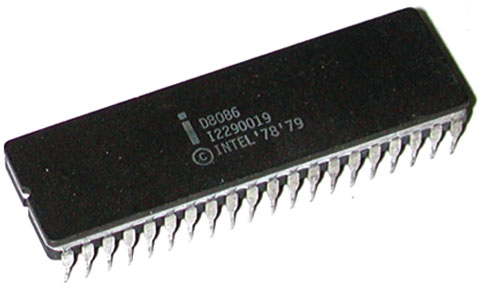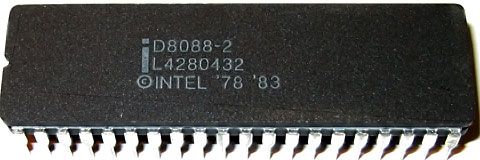The IBM PC of August 1981 was build around Intel’s 8088 processor, a CPU released over two years earlier in June 1979. The 8088 itself was designed as a version of Intel’s 16-bit 8086, but on an 8-bit bus instead of a 16-bit bus. Although this made the 8088 a bit less efficient than the 8086, it was easier to design a computer using an 8-bit bus, so the 8088 became the standard CPU of the IBM PC, XT, and early compatibles.
 The 8086, introduced in June 1978, has a 16-bit bus and can address 1 MB of RAM (random access memory), sixteen times as much as the earlier 8080 CPU. The 8086 initially shipped at 5 MHz, later reaching 8 MHz and 10 MHz speeds, while the 8088 started life at 4.77 MHz. According to Intel, the 10 MHz 8086 has 10x the performance of the 2 MHz 8080.
The 8086, introduced in June 1978, has a 16-bit bus and can address 1 MB of RAM (random access memory), sixteen times as much as the earlier 8080 CPU. The 8086 initially shipped at 5 MHz, later reaching 8 MHz and 10 MHz speeds, while the 8088 started life at 4.77 MHz. According to Intel, the 10 MHz 8086 has 10x the performance of the 2 MHz 8080.
Byte magazine (May 1993) notes that the 8086 has a MIPS (million instructions per second) rating of 0.33 (4.77 MHz, as in the IBM PC) to 0.75 (for the 10 MHz CPU).
 The 8086 and 8088 have 29,000 transistors and used 3 micron traces. This is nearly five times as many transistors as the 8080. The 8086/88 includes a six-byte prefetch queue to improve performance, which can be considered a primitive form of pipelining.
The 8086 and 8088 have 29,000 transistors and used 3 micron traces. This is nearly five times as many transistors as the 8080. The 8086/88 includes a six-byte prefetch queue to improve performance, which can be considered a primitive form of pipelining.
In designing the 8086, Intel chose to leverage the 8080 design as much as possible, so intead of giving the CPU a linear address space, the 8086 sees RAM in 64 KB segments. When IBM designed its first PC, they elected to leave 10 segments for RAM and assign the remaining six to other system functions, giving rise to the 640 KB ceiling of most early PCs.
The bank-switched architecture of the 8086 had many negative impacts on PC hardware and software design (for instance, data structures over 64 KB were much harder to work with), since later computers designed around more powerful processors still had to deal with a hardware design that tied up the space between 640 KB and 1 MB for many system functions.
NEC’s V20 & V30
The NEC V20 and V30 are functionally similar to the 8088 and 8086, respectively, although they are slightly more efficient designs. (I think mine benchmarked at 15% faster.) They are pin-compatible, so back in the PC and XT era, it was quite easy and inexpensive to replace the Intel CPU with the slighly more powerful NEC equivalent. clock speeds ranged from 8 MHz to 16 MHz.
In addition to the 8086 commands, the V20 and V30 include instructions Intel introduced with the 80186/88, a CPU that to my knowledge was only used in one desktop PC in the US market – the Tandy 2000.
Another benefit of the V20 and V30 was the ability to fully emulate the older 8080 processor. This allowed designers to avoid the kind of hardware gymnastics Zenith devised for the clever dual-processor Z-100, a personal computer with both an 8085 and an 8088.
The 8087 Math Coprocessor
Intel designed a math coprocessor, the 8087, to work in conjunction with the 8086 and 8088. For the few programs that support it, the 8087 really improves calculation speed.
Next: Intel 80186
Intel CPU Series: 8080/Z-80, 8086/88, 80186/88, 80286, 80386, 80486, Pentium, Pentium MMX, Pentium Pro, Pentium II, Pentium III, Pentium 4, Pentium D, Pentium M/Core Duo, Core 2 Duo, Core i
Further Reading
Keywords: #intel8086 #intel8088 #necv20 #mecv30 #intel8087
Short link: http://goo.gl/XnxlpM
searchword: intel8086

